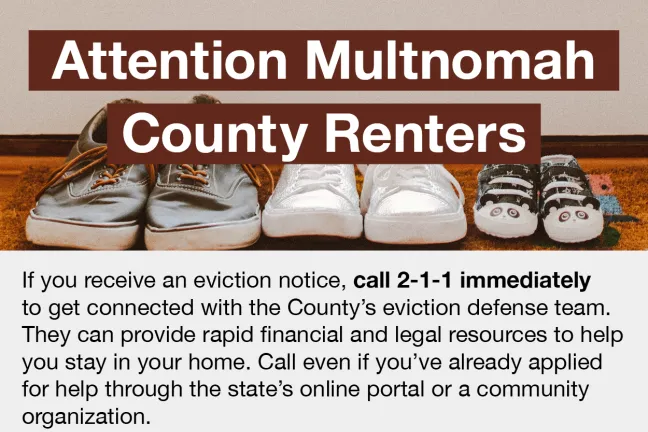Multnomah County announced that it will begin a three-day text message campaign on Monday, Dec. 13, 2021, to alert cell phone users in Multnomah County on how to find financial and legal assistance if they receive a notice of eviction for nonpayment of rent. Approximately 370,000 residents are expected to receive the text over the course of the campaign, which is slated to run Monday through Wednesday. It is part of a multi-pronged effort to keep people housed by telling them how to get help.
The alert, written in English and Spanish, tells residents to call 2-1-1 immediately if they receive an eviction notice. The text message reads as the following:
Message from Multnomah County:
Renters, if you receive a notice of eviction, call 211 immediately. Financial and legal help is available.
Inquilinos, si recibe un aviso de desalojo, llame al 211 de inmediato. Hay ayuda financiera y legal disponible.
For more information/para más información: multco.us/rentrelief
The URL at the end of the message will appear with a different domain (e.g., evictionaid.online, evictionaid.site, evictionaid.click, evictionaid.link, evictionhelp.link, etc.).
Frequently Asked Questions
How was the list of recipients gathered?
The list of phone numbers comes from our vendor’s data partners, who leverage publicly available sources such as voter registration files, along with commercial marketing sources, to help enrich the file and pull unregistered residents. It’s similar to the process of building out direct mail lists.
How many people did this text message go out to?
The campaign will reach approximately 370,000 residents over three days (Monday, Dec. 13, through Wednesday, Dec. 15).
Why the campaign?
This campaign aims to let renters in the county know that calling 2-1-1 is the most immediate step they can take if they ever receive an eviction notice for nonpayment of rent during the pandemic. After a screening, 211info may connect callers to Multnomah County’s eviction defense team.
The text message also points people to multco.us/rentrelief, where people can find information about eviction protections, namely the safe harbor protections offered by SB 278. The webpage will continue to be updated with new information relevant to renter protections and rent assistance as it becomes available.
How can recipients be removed?
Anyone can opt out by texting back “unsubscribe,” “opt out,” “stop” or any similar phrase. The phone number will be removed from the list, and the individual will be removed from any future campaigns that Multnomah County uses this particular vendor for.
Why is the text message this length?
We are limited by the word count best practices as advised by our vendor. Our top goals were making sure people know what to do if/when they receive a notice of eviction; providing a webpage where that message is reinforced and where they are pointed to the main avenue for applying for rent relief (which makes them eligible for safe harbor); and increasing accessibility by including a Spanish version of the English message.
Why are the URLs different from the actual County website domain?
This is a practice done by the vendor to keep their text message campaign from being flagged as spam by wireless carriers. It also aids in tracking click-through performance of the campaign.
What else is the County doing to make sure people have this information?
Multnomah County’s highest priority has been — and continues to be — preventing people from losing their homes. The County and our network of community-based rent assistance partners have worked together to help thousands of families obtain rent relief and stay housed. However, that work has taken place amidst a rent assistance and eviction prevention policy landscape that during the COVID-19 pandemic continues to be unpredictable.
Outreach efforts include:
- Outreach workers going door to door to share information about eviction prevention assistance, as well as meeting people at the Courthouse who are already in a legal proceeding.
- Facebook ads to reach users in Multnomah County with information about how to get help.
- Ads in culturally specific newspapers and/or their websites.
- Flyers posted in public-facing County buildings, as well as in the facilities of numerous Joint Office partners.

